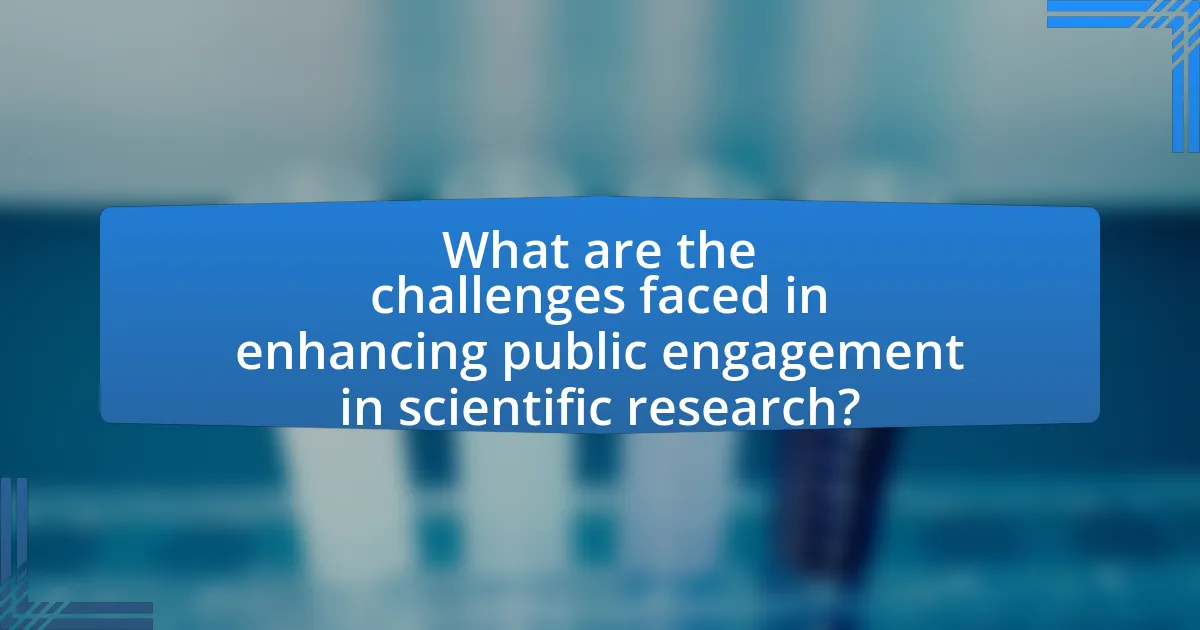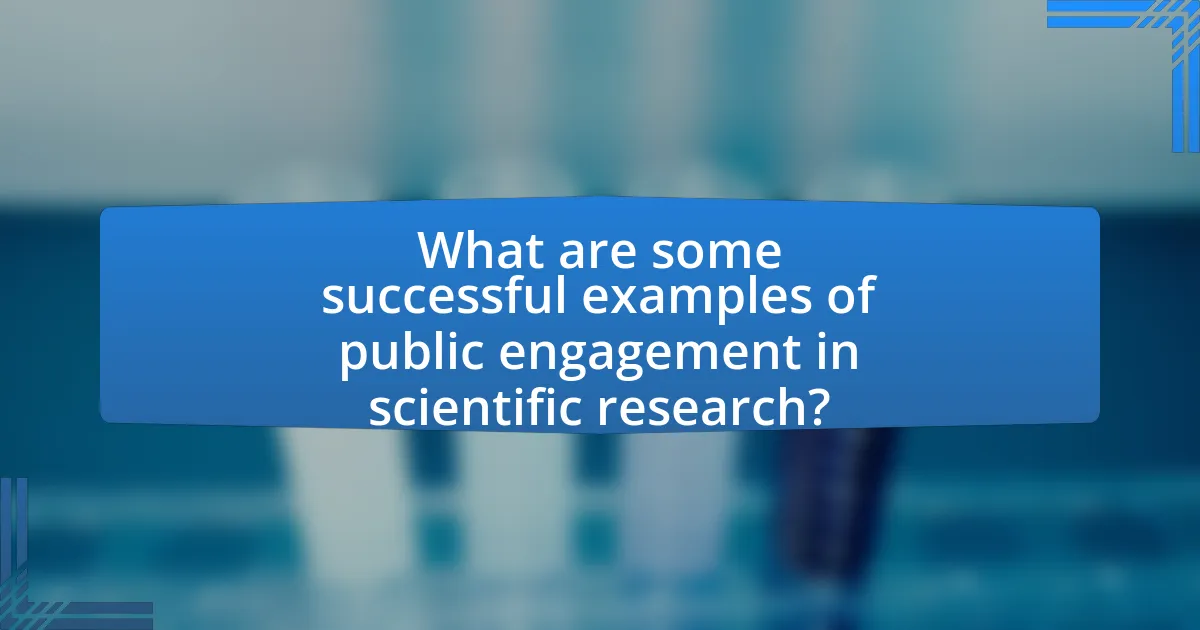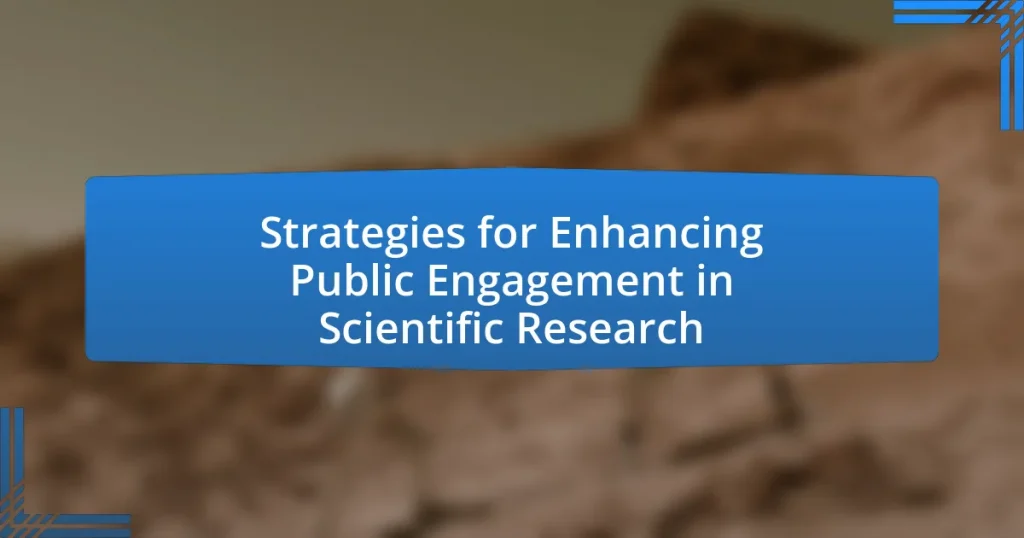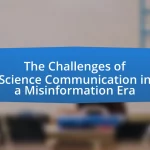The article focuses on strategies for enhancing public engagement in scientific research, emphasizing effective communication, community involvement, and the utilization of digital platforms. It outlines methods for scientists to communicate their research clearly, including the use of storytelling and accessible language, while highlighting the importance of interactive workshops and social media campaigns for fostering dialogue. The article also addresses challenges such as communication barriers and public trust, and discusses successful examples of public engagement initiatives, including citizen science projects and science festivals. Key takeaways for scientists include prioritizing transparency, inclusivity, and feedback mechanisms to improve public understanding and support for scientific endeavors.

What are the key strategies for enhancing public engagement in scientific research?
Key strategies for enhancing public engagement in scientific research include effective communication, community involvement, and the use of digital platforms. Effective communication involves simplifying complex scientific concepts and using relatable language to make research accessible to a broader audience. Community involvement can be achieved through participatory research initiatives, where the public contributes to the research process, fostering a sense of ownership and relevance. The use of digital platforms, such as social media and interactive websites, allows researchers to reach diverse audiences, share findings in real-time, and encourage dialogue. These strategies have been shown to increase public interest and understanding of scientific research, as evidenced by studies indicating that community-based participatory research leads to higher engagement levels and improved public perceptions of science.
How can scientists effectively communicate their research to the public?
Scientists can effectively communicate their research to the public by utilizing clear language, engaging storytelling, and accessible platforms. Clear language ensures that complex scientific concepts are understandable, while engaging storytelling captures the audience’s interest and makes the research relatable. Accessible platforms, such as social media, public talks, and community events, allow scientists to reach diverse audiences. Research indicates that when scientists use these strategies, they can significantly improve public understanding and interest in science, as evidenced by studies showing increased engagement metrics when scientists employ relatable narratives and simplified terminology.
What communication methods are most effective for public engagement?
Effective communication methods for public engagement include interactive workshops, social media campaigns, and community forums. Interactive workshops allow participants to engage directly with researchers, fostering a two-way dialogue that enhances understanding and interest. Social media campaigns leverage platforms like Twitter and Facebook to reach broader audiences quickly, facilitating real-time interaction and feedback. Community forums provide a space for open discussion, enabling the public to voice concerns and ask questions, which can lead to increased trust and collaboration. Research indicates that these methods significantly improve public understanding and involvement in scientific topics, as evidenced by studies showing higher engagement levels when using interactive and participatory approaches.
How can storytelling enhance the understanding of scientific concepts?
Storytelling enhances the understanding of scientific concepts by making complex information relatable and memorable. When scientific ideas are presented through narratives, they engage emotions and create connections, which facilitate better retention and comprehension. Research indicates that stories can improve recall by up to 22 times compared to facts alone, as demonstrated in studies by the Stanford Graduate School of Business. This approach allows audiences to visualize concepts, understand their implications, and relate them to real-life experiences, ultimately fostering a deeper appreciation for science.
Why is public engagement important in scientific research?
Public engagement is important in scientific research because it fosters trust, enhances the relevance of research, and encourages informed decision-making. Engaging the public allows researchers to understand community needs and perspectives, which can lead to more applicable and impactful research outcomes. Studies, such as the National Science Foundation’s report on public understanding of science, indicate that increased public involvement can improve the quality of scientific inquiry and promote transparency. Furthermore, public engagement helps demystify science, making it more accessible and relatable, which can ultimately lead to greater public support for scientific initiatives and funding.
What role does public trust play in scientific research outcomes?
Public trust significantly influences scientific research outcomes by enhancing collaboration, increasing funding opportunities, and improving the acceptance of scientific findings. When the public trusts scientists and their institutions, they are more likely to support research initiatives, participate in studies, and accept the results, which can lead to more effective implementation of scientific advancements. For instance, a study published in the journal “Nature” found that public trust in scientists correlates with higher levels of public engagement in research activities, which ultimately leads to better health outcomes and policy decisions. This relationship underscores the importance of maintaining transparency and ethical standards in scientific practices to foster trust and, consequently, positive research outcomes.
How can public engagement influence policy decisions in science?
Public engagement can significantly influence policy decisions in science by ensuring that the perspectives and needs of the community are integrated into the decision-making process. When scientists and policymakers actively involve the public, they can gather diverse viewpoints that reflect societal values and priorities, leading to more relevant and accepted policies. For instance, the National Science Foundation’s 2018 report highlighted that public input on climate change policies resulted in more effective and widely supported initiatives. This demonstrates that when public engagement is prioritized, it can lead to policies that are not only scientifically sound but also socially acceptable and beneficial.

What are the challenges faced in enhancing public engagement in scientific research?
Enhancing public engagement in scientific research faces several challenges, including communication barriers, lack of trust, and limited accessibility. Communication barriers arise from the complex nature of scientific language, which can alienate non-experts. A study by the National Science Foundation found that 70% of the public feels overwhelmed by scientific jargon, hindering effective dialogue. Lack of trust in scientific institutions, often fueled by misinformation and past controversies, further complicates engagement efforts; surveys indicate that only 36% of Americans trust scientists to act in the public’s best interest. Additionally, limited accessibility to scientific resources and events restricts participation, particularly among marginalized communities, as highlighted by the Pew Research Center, which reported that 40% of low-income individuals feel excluded from scientific discussions. These factors collectively impede the goal of fostering a more informed and engaged public in scientific discourse.
What barriers exist that hinder effective public engagement?
Barriers that hinder effective public engagement include lack of awareness, limited accessibility, and communication gaps. Lack of awareness arises when the public is not informed about scientific research initiatives, leading to disengagement. Limited accessibility refers to the difficulties faced by certain demographics, such as individuals with disabilities or those in remote areas, in accessing information and participating in engagement activities. Communication gaps occur when scientific information is presented in overly technical language, making it difficult for the general public to understand and engage meaningfully. These barriers collectively impede the ability of researchers to connect with the public and foster collaborative dialogue.
How does scientific jargon affect public understanding?
Scientific jargon negatively affects public understanding by creating barriers to comprehension. When experts use specialized terminology, it can alienate non-experts, leading to confusion and disengagement from scientific discourse. Research indicates that approximately 80% of the general public struggles to understand scientific articles due to complex language, which hinders informed decision-making on critical issues like health and environmental policies. Simplifying language and using clear explanations can significantly enhance public engagement and understanding of scientific concepts.
What are the misconceptions about science that need to be addressed?
Misconceptions about science that need to be addressed include the belief that science is infallible, the idea that scientific theories are mere guesses, and the notion that science is separate from everyday life. Science is a self-correcting process that evolves with new evidence, as demonstrated by the historical shifts in understanding, such as the transition from Newtonian physics to Einstein’s theory of relativity. Additionally, scientific theories, like the theory of evolution, are well-supported frameworks based on extensive evidence, not just speculative ideas. Furthermore, science influences daily decisions, from medical treatments to environmental policies, highlighting its relevance in everyday life. Addressing these misconceptions is crucial for fostering a more informed public that values scientific inquiry and its applications.
How can researchers overcome these challenges?
Researchers can overcome challenges in enhancing public engagement by employing effective communication strategies and fostering collaborative partnerships. By simplifying complex scientific concepts into accessible language, researchers can better connect with diverse audiences. Additionally, engaging with community organizations and stakeholders allows researchers to tailor their outreach efforts to specific interests and needs, thereby increasing relevance and impact. Evidence shows that initiatives like the National Science Foundation’s “Broader Impacts” criterion have successfully encouraged researchers to prioritize public engagement, leading to increased participation and understanding of scientific research among the general public.
What training or resources are available for scientists to improve engagement skills?
Scientists can improve engagement skills through various training programs and resources, including workshops, online courses, and mentorship opportunities. For instance, the National Science Foundation offers the “Science Communication Training” program, which focuses on effective communication strategies for scientists. Additionally, organizations like the American Association for the Advancement of Science provide resources such as the “Communicating Science” toolkit, which includes guidelines and best practices for engaging with the public. These programs are designed to enhance scientists’ abilities to convey complex information clearly and effectively, thereby fostering better public understanding and interest in scientific research.
How can collaboration with community organizations enhance outreach efforts?
Collaboration with community organizations enhances outreach efforts by leveraging local knowledge and networks to reach diverse audiences effectively. Community organizations often have established trust and rapport within their communities, which can facilitate engagement and participation in outreach activities. For instance, a study published in the Journal of Community Engagement and Scholarship found that partnerships between universities and local organizations increased participation in public health initiatives by 40%, demonstrating the effectiveness of such collaborations in enhancing outreach.

What are some successful examples of public engagement in scientific research?
Successful examples of public engagement in scientific research include the Citizen Science movement, where non-professionals contribute to scientific data collection and analysis. Projects like the Audubon Society’s Christmas Bird Count involve thousands of volunteers who gather data on bird populations, which informs conservation efforts. Another example is the Human Genome Project, which engaged the public through educational outreach and discussions about genetic research, fostering a better understanding of genomics. Additionally, the Zooniverse platform allows the public to participate in various research projects, from classifying galaxies to transcribing historical documents, demonstrating the effectiveness of collaborative science. These initiatives illustrate how public involvement can enhance scientific research outcomes and community awareness.
What initiatives have proven effective in engaging the public with science?
Initiatives such as science festivals, citizen science projects, and interactive science centers have proven effective in engaging the public with science. Science festivals, like the Edinburgh Science Festival, attract thousands of attendees and offer hands-on activities, talks, and demonstrations that make science accessible and enjoyable. Citizen science projects, such as the Audubon Society’s Christmas Bird Count, involve the public in data collection and analysis, fostering a sense of contribution and ownership in scientific research. Interactive science centers, exemplified by the Exploratorium in San Francisco, provide immersive experiences that encourage exploration and curiosity about scientific concepts. These initiatives have been shown to increase public interest and understanding of science, as evidenced by participant surveys and engagement metrics.
How have citizen science projects contributed to public engagement?
Citizen science projects have significantly enhanced public engagement by actively involving individuals in scientific research processes. These projects empower citizens to contribute data, analyze results, and participate in decision-making, fostering a sense of ownership and connection to scientific endeavors. For instance, studies show that participation in citizen science can increase public understanding of scientific concepts and methodologies, as evidenced by the success of projects like the Audubon Society’s Christmas Bird Count, which has engaged over 100,000 volunteers annually since 1900, leading to increased awareness of avian populations and conservation issues. This direct involvement not only democratizes science but also cultivates a community of informed citizens who are more likely to support and advocate for scientific initiatives.
What role do social media campaigns play in promoting scientific research?
Social media campaigns play a crucial role in promoting scientific research by increasing visibility and accessibility of research findings to a broader audience. These campaigns leverage platforms like Twitter, Facebook, and Instagram to disseminate information quickly, engage with the public, and foster discussions around scientific topics. For instance, a study published in the journal “PLOS ONE” found that research shared on social media received 10 times more attention than traditional dissemination methods, highlighting the effectiveness of these campaigns in reaching diverse demographics. Additionally, social media allows researchers to connect directly with the public, enhancing transparency and trust in science, which is essential for public engagement in scientific research.
What best practices can be adopted for future public engagement efforts?
To enhance future public engagement efforts, organizations should prioritize transparency, inclusivity, and feedback mechanisms. Transparency builds trust by openly sharing research goals, methods, and outcomes, as evidenced by studies showing that clear communication increases public support for scientific initiatives. Inclusivity ensures diverse community representation, which can be achieved through targeted outreach and partnerships with local organizations, reflecting the findings of the National Science Foundation that diverse perspectives enrich scientific discourse. Implementing structured feedback mechanisms allows for continuous improvement, as demonstrated by the success of initiatives that adapt based on community input, leading to more effective engagement strategies.
How can feedback from the public be integrated into research practices?
Feedback from the public can be integrated into research practices through structured mechanisms such as surveys, focus groups, and public consultations. These methods allow researchers to gather diverse perspectives and insights directly from the community, ensuring that research agendas align with public interests and needs. For instance, the National Institutes of Health (NIH) emphasizes community engagement in research, highlighting that involving the public can enhance the relevance and applicability of scientific findings. Additionally, incorporating public feedback can lead to improved trust and transparency in the research process, as evidenced by studies showing that participatory research approaches increase community support and collaboration.
What are the key takeaways for scientists looking to enhance public engagement?
Scientists looking to enhance public engagement should prioritize clear communication, active listening, and collaboration with diverse communities. Clear communication involves using accessible language and relatable examples to explain complex scientific concepts, which can significantly improve public understanding and interest. Active listening allows scientists to understand public concerns and interests, fostering a two-way dialogue that builds trust and relevance. Collaboration with diverse communities, including schools, local organizations, and social media platforms, expands outreach and encourages participation in scientific discussions. Research indicates that effective public engagement can lead to increased support for science funding and policy, as demonstrated by studies showing that communities involved in science outreach programs exhibit higher levels of trust in scientific institutions.


